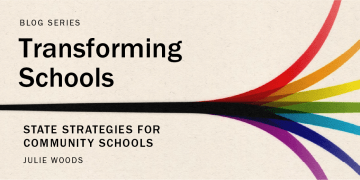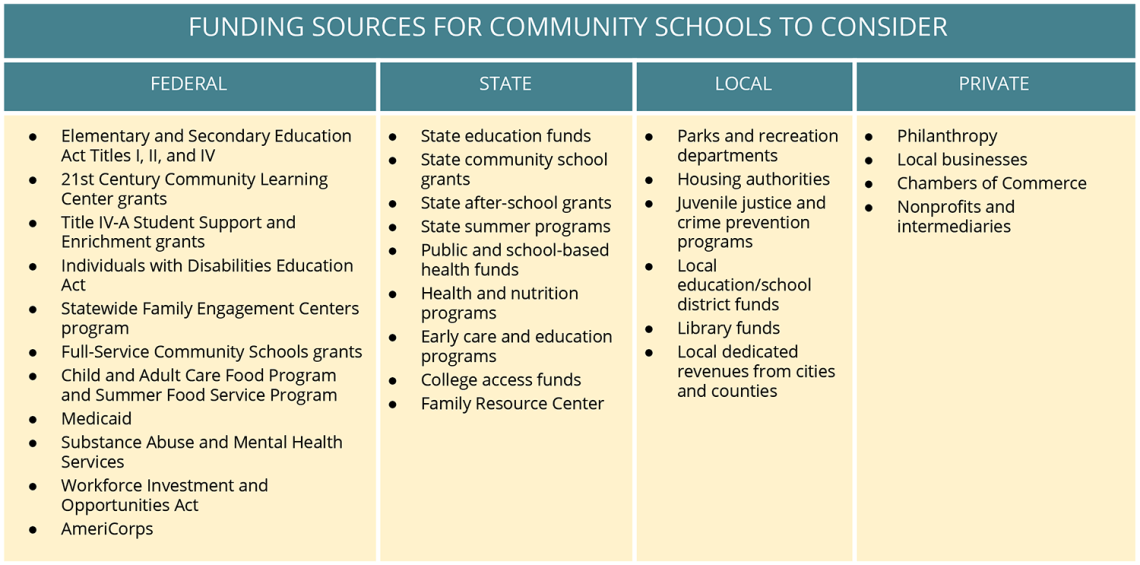State Strategies for Investing in Community Schools

This blog is part of the Transforming Schools series, which shares effective practices and foundational research for educators, students, families, and policymakers who are reimagining schools as places where students are safe and can thrive academically, socially, and emotionally.
State legislative sessions are wrapping up, with a growing number of states considering community schools as a way to address student mental health and chronic absenteeism and to support learning recovery in the wake of the COVID-19 pandemic.
In Montana, for example, Missoula County Public Schools leaders recently reported at a legislative education interim committee meeting that their community school’s expanded learning time allows families to continue to afford to live in their community by providing much-needed after-school care, while its focus on a two-generation approach to engaging families is helping in “breaking the chronic attendance cycle.”
Increasingly, the nation’s students are served by community schools, and with states such as California, Illinois, and Vermont implementing statewide initiatives, that number is expected to grow.
Community schools are a research-based approach that transforms a school into a place where educators, local community members, families, and students work together to strengthen conditions for student learning and healthy development. As partners, they organize in- and out-of-school resources, supports, and opportunities so that young people can learn and thrive. By creating a supportive ecosystem for students and families, community schools can address many of the challenges—from learning loss to chronic absenteeism—that states face in the wake of the COVID-19 pandemic.
Historic Federal Investments Position States for Systemic Student Support
To make community schools a reality for more students, many states—including Idaho, Missouri, New Hampshire, and Ohio—are leveraging the federal Full-Service Community Schools (FSCS) grant program to expand community schools. In late 2023, the U.S. Department of Education distributed $74 million in these grants to 30 communities together serving more than 100 districts and nearly 300,000 students.
Aided by this historic federal investment, states can begin to support systemic approaches (rather than one-off efforts) to expand community schools and support student well-being and academic recovery by leveraging a range of federal, state, local, and private funds.
State-Level Strategies to Braid Federal, State, and Private Funding
To set up sustainable systems of community schools, state policymakers can combine resources from a variety of funding sources (see table below).
Along with other funds, federal sources include the Full-Service Community Schools program, Elementary and Secondary Education Act funding, and Elementary and Secondary School Emergency Relief (ESSER) funds, as well as less obvious sources such as Medicaid. In some cases, federal grants such as the FSCS grant can seed innovation that leads to additional state investments. A comprehensive list of federal funding sources can be found through the White House Federal Resources to Support Community Schools toolkit.
Three potential approaches to state investments in community schools are (1) ongoing support through school funding formulas; (2) competitive grant funding; and (3) capacity-building supports, such as school certification processes that can include grants, state agency support, and professional learning opportunities. States often combine these approaches, along with federal support, to establish and sustain community schools.
Following are examples from two states that have been implementing community school initiatives successfully through a range of funding sources.
Maryland: Federal ESSA Funds and State Grant Program
Maryland has recently increased its statewide commitment to community schools, building on early successes. A community school parent described her school as “an important base for our community” and a “home for me and my family,” where “there is trust and friendship.”
Maryland first supported community schools through 2016 legislation directing the state to notify districts that they can use Every Student Succeeds Act (ESSA) Title I funds for community schools and to encourage districts to apply for ESSA Title IV funds to pay for community school coordinators and related expenses.
In 2020, leveraging its landmark education legislation, the Blueprint for Maryland’s Future (a state education reform effort), Maryland established the Concentration of Poverty entitlement grant program. Among other things, the Blueprint provides funding to create and support community schools in low-income settings. It also provides funding for essential community school staff and additional per-pupil funding for community schools on a sliding scale.
In 2022, the program distributed a total of $116.7 million in state aid to 300 eligible schools (approximately 21% of all public schools in the state), each of which received $248,833 in personnel grants.
Vermont: Federal Recovery Funds Grant Program
Vermont’s Community Schools Act appropriated approximately $3.4 million in ESSER funding from the American Rescue Plan Act to develop a competitive grant program. In 2021, the state began awarding funds (between $50,000 and $250,000 annually) to support 16 community schools in five participating districts through the 3-year pilot grant program.
As a COVID-19 recovery strategy for small and rural communities across the state, the Community Schools Act prioritizes schools in high-need districts, including Title I schools—schools with 40% or more of students qualifying for free or reduced-price meals, or schools that have been identified for support and intervention under ESSA.
As with most things in life and education, one size does not fit all. As state policymakers consider the best ways to blend and braid the multiple funding sources available for community school implementation, they will need to consider their unique context, funding streams, and student needs. In every case, however, a variety of strategies are available to sustainably support and fund community school systems. These intentional investments in time and resources are key to effective implementation of community schools that are proven to help students thrive, both in the classroom and beyond.

